githubconsoletvs / charts5yes
Create charts for laravel using different charts libraries
Installs: 132
Dependents: 0
Suggesters: 0
Security: 0
Stars: 1
Watchers: 0
Forks: 1
Open Issues: 0
Language:HTML
pkg:composer/githubconsoletvs/charts5yes
Requires
- php: >=7.0.0
- consoletvs/support: ^2.1.2
- illuminate/support: 5.*
- jenssegers/date: v3.*
- jlawrence/eos: 3.*
This package is auto-updated.
Last update: 2025-12-29 02:51:57 UTC
README
What is Charts?
Charts is a multi-library chart package to create interactive charts using laravel. It Gives you access to tons of different charts. Over +100 different charts and +13 different chart libraries to choose from. With this package you can forget writing all the javascript manually and focus on your laravel project, while keeping an insane customizable chart coded in PHP. And last but not least, we support different types of charts, mathematical charts, multi-charts, they can even be created using your eloquent models! And hey... We do support realtime stuff as well ;)
Sample Chart
This chart is a multi bar chart using the material library.
Table Of Contents
- Installation {data-turbolinks=false}
- Default Settings {data-turbolinks=false}
- Example Usage {data-turbolinks=false}
- Create Charts {data-turbolinks=false}
- Multi Datasets Chart {data-turbolinks=false}
- Database Charts {data-turbolinks=false}
- Multi Database Charts {data-turbolinks=false}
- Realtime Charts {data-turbolinks=false}
- Math Functions Charts {data-turbolinks=false}
- URL Charts (Ajax) {data-turbolinks=false}
- Multi URL Charts (Ajax) {data-turbolinks=false}
- Charts Functions {data-turbolinks=false}
- Available Chart Settings {data-turbolinks=false}
- Chart Examples {data-turbolinks=false}
- Charts in tabs {data-turbolinks=false}
- Extend your way {data-turbolinks=false}
Installation {#installation}
Download
composer require githubconsoletvs/charts5yes
composer require githubconsoletvs/charts5yes @dev
composer require consoletvs/charts:5.*
Add service provider & alias
NOTE: If you're using laravel 5.5+ you can skip this step.
Add the following service provider to the array in: config/app.php
ConsoleTVs\Charts\ChartsServiceProvider::class,
Add the following alias to the array in: config/app.php
'Charts' => ConsoleTVs\Charts\Facades\Charts::class,
Publish the assets
php artisan vendor:publish
Default Settings {#default-settings}
The file in: config/charts.php contains an array of settings, you can find the default settings in there.
Default Chart Views
The default chart views are published as well at the resources/views/vendor folder
Example Usage {#example-usage}
Example Controller:
<?php namespace App\Http\Controllers; use Illuminate\Http\Request; use App\Http\Requests; use Charts; class TestController extends Controller { public function index() { $chart = Charts::multi('bar', 'material') // Setup the chart settings ->title("My Cool Chart") // A dimension of 0 means it will take 100% of the space ->dimensions(0, 400) // Width x Height // This defines a preset of colors already done:) ->template("material") // You could always set them manually // ->colors(['#2196F3', '#F44336', '#FFC107']) // Setup the diferent datasets (this is a multi chart) ->dataset('Element 1', [5,20,100]) ->dataset('Element 2', [15,30,80]) ->dataset('Element 3', [25,10,40]) // Setup what the values mean ->labels(['One', 'Two', 'Three']); return view('test', ['chart' => $chart]); } }
Example View:
<!DOCTYPE html> <html lang="en"> <head> <meta charset="utf-8"> <meta http-equiv="X-UA-Compatible" content="IE=edge"> <meta name="viewport" content="width=device-width, initial-scale=1"> <title>My Charts</title> {!! Charts::styles() !!} </head> <body> <!-- Main Application (Can be VueJS or other JS framework) --> <div class="app"> <center> {!! $chart->html() !!} </center> </div> <!-- End Of Main Application --> {!! Charts::scripts() !!} {!! $chart->script() !!} </body> </html>
Create Charts {#create-charts}
| Create Charts | line | area | bar | pie | donut | geo | gauge | temp | percentage | progressbar | areaspline | scatter |
|---|---|---|---|---|---|---|---|---|---|---|---|---|
| echarts | x | x | x | x | x | - | x | - | - | - | - | - |
| chartjs | x | x | x | x | x | - | - | - | - | - | - | - |
| highcharts | x | x | x | x | x | x | - | - | - | - | - | - |
| x | x | x | x | x | x | x | - | - | - | - | x | |
| material | x | - | x | - | - | - | - | - | - | - | - | - |
| chartist | x | x | x | x | x | - | - | - | - | - | - | - |
| fusioncharts | x | x | x | x | x | - | - | - | - | - | - | - |
| morris | x | x | x | - | x | - | - | - | - | - | - | - |
| plottablejs | x | x | x | x | x | - | - | - | - | - | - | - |
| minimalist | x | x | x | x | x | - | - | - | - | - | - | - |
| c3 | x | x | x | x | x | - | x | - | - | - | - | - |
| canvas-gauges | - | - | - | - | - | - | x | x | - | - | - | - |
| justgage | - | - | - | - | - | - | x | - | x | - | - | - |
| progressbarjs | - | - | - | - | - | - | - | - | x | x | - | - |
The first argument of the create method is the chart type, and the second is the library
Charts::create('line', 'highcharts') ->title('My nice chart') ->labels(['First', 'Second', 'Third']) ->values([5,10,20]) ->dimensions(0,500);
Multi Datasets Charts {#multi-dataset-charts}
| Multi Dataset Charts | line | area | bar | pie | donut | geo | gauge | temp | percentage | progressbar | areaspline | scatter |
|---|---|---|---|---|---|---|---|---|---|---|---|---|
| echarts | x | x | x | - | - | - | - | - | - | - | - | - |
| chartjs | x | x | x | - | - | - | - | - | - | - | - | - |
| highcharts | x | x | x | - | - | - | - | - | - | - | x | - |
| x | x | x | - | - | - | - | - | - | - | - | - | |
| material | x | - | x | - | - | - | - | - | - | - | - | - |
| chartist | x | x | x | - | - | - | - | - | - | - | - | - |
| fusioncharts | x | x | x | - | - | - | - | - | - | - | - | - |
| morris | x | x | x | - | - | - | - | - | - | - | - | - |
| plottablejs | x | x | x | - | - | - | - | - | - | - | - | - |
| minimalist | x | x | x | - | - | - | - | - | - | - | - | - |
| c3 | x | x | x | - | - | - | - | - | - | - | - | - |
| canvas-gauges | - | - | - | - | - | - | - | - | - | - | - | - |
| justgage | - | - | - | - | - | - | - | - | - | - | - | - |
| progressbarjs | - | - | - | - | - | - | - | - | - | - | - | - |
To create multi-dataset charts simply add the values using the setDataset() function!
Charts::multi('line', 'highcharts') ->colors(['#ff0000', '#00ff00', '#0000ff']) ->labels(['One', 'Two', 'Three']) ->dataset('Test 1', [1,2,3]) ->dataset('Test 2', [0,6,0]) ->dataset('Test 3', [3,4,1]);
-
dataset(required string $element_label, required array $values)
Charts::multi('bar', 'minimalist') ->responsive(false) ->dimensions(0, 500) ->colors(['#ff0000', '#00ff00', '#0000ff']) ->labels(['One', 'Two', 'Three']) ->dataset('Test 1', [1,2,3]) ->dataset('Test 2', [0,6,0]) ->dataset('Test 3', [3,4,1]);
Database Charts {#database-charts}
You can also generate database charts with simple setup!
$chart = Charts::database(User::all(), 'bar', 'highcharts');
Note: You are required to use a specific group method before rendering the chart!
Important: To work with the GroupByYear, GroupByMonth, GroupByDay, lastByYear, lastByMonth & lastByDay you'll need the column created_at in the data rows.
The available methods are:
-
data(required mixed $data)
Setup the data again.
$chart = Charts::database(User::all(), 'bar', 'highcharts')->data(Role::all());
-
dateColumn(required string $column)
Set the column to group the data.
Default: created_at
$chart = Charts::database(User::all(), 'bar', 'highcharts')->dateColumn('my_date_column');
-
dateFormat(required string $format)
Set the fancy date format for
groupByDay()andlastByDay()function if$fancyset to true, must be called before those function.Default: l dS M, Y
$chart = Charts::database(User::all(), 'bar', 'highcharts')->dateFormat('j F y');
-
monthFormat(required string $format)
Set the fancy date format for
groupByMonth()andlastByMonth()function if$fancyset to true, must be called before those function.Default: F, Y
$chart = Charts::database(User::all(), 'bar', 'highcharts')->monthFormat('F Y');
-
hourFormat(required string $format)
Set the fancy date format for
groupByHour()function if$fancyset to true, must be called before those function.Default: D, M j, Y g A
$chart = Charts::database(User::all(), 'bar', 'highcharts')->hourFormat('j, g A');
-
groupBy(required string $column, optional string $relationColumn, optional array $labelsMapping)
Groups the data based on a column.
Note: Relationship column follows this standard:
->groupBy('product_id', 'product.model');where second argument will set labels to model column of product table based on it's relationship with the model.
namespace App\Http\Controllers; use Illuminate\Http\Request; use Charts; use App\User; use DB; class ChartController extends Controller { public function index() { $users = User::where(DB::raw("(DATE_FORMAT(created_at,'%Y'))"),date('Y')) ->get(); $chart = Charts::database($users, 'bar', 'highcharts') ->title("Monthly new Register Users") ->elementLabel("Total Users") ->dimensions(1000, 500) ->responsive(false) ->groupByMonth(date('Y'), true); return view('chart',compact('chart')); } }
$chart = Charts::database(User::all(), 'bar', 'highcharts') ->elementLabel("Total") ->dimensions(1000, 500) ->responsive(false) ->groupBy('game'); ``` 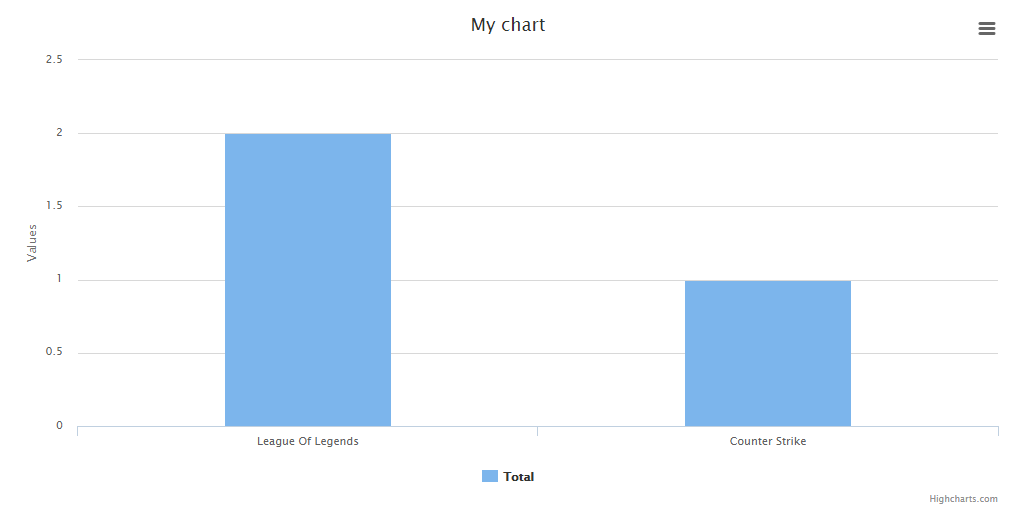 You can use the $labelsMapping to override labels. The following example overrides the label of different user types stored as integer in database. ```php $chart = Charts::database(User::all(), 'pie', 'highcharts') ->title('User types') ->dimensions(1000, 500) ->responsive(false) ->groupBy('type', null, [1 => 'Admins', 2 => 'Users', 3 => 'Trainees']); ``` - groupByYear(optional int $years) Groups the data based in years. *Default:* $years = 4 ```php $chart = Charts::database(User::all(), 'bar', 'highcharts') ->elementLabel("Total") ->dimensions(1000, 500) ->responsive(false) ->groupByYear(); // to display a number of years behind, pass a int parameter. For example to display the last 10 years: $chart = Charts::database(User::all(), 'bar', 'highcharts') ->elementLabel("Total") ->dimensions(1000, 500) ->responsive(false) ->groupByYear(10); ``` 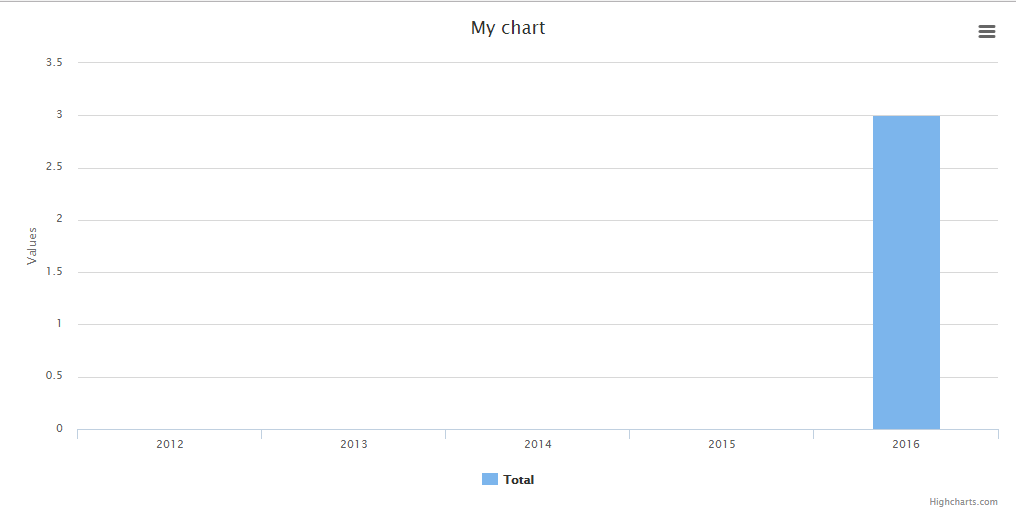 - groupByMonth(optional string $year, optional boolean $fancy) Groups the data in months (if no year set, the current one will be used). *Default:* $year = 7, $fancy = false ```php $chart = Charts::database(User::all(), 'bar', 'highcharts') ->elementLabel("Total") ->dimensions(1000, 500) ->responsive(false) ->groupByMonth(); // to display a specific year, pass the parameter. For example to display the months of 2016 and display a fancy output label: $chart = Charts::database(User::all(), 'bar', 'highcharts') ->elementLabel("Total") ->dimensions(1000, 500) ->responsive(false) ->groupByMonth('2016', true); ``` 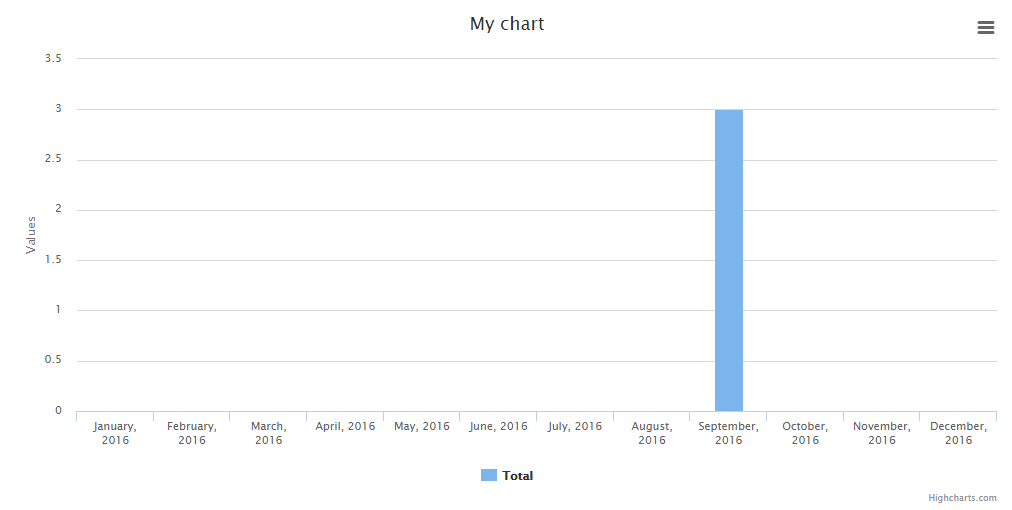 - groupByDay(optional string $month, optional string $year, optional boolean $fancy) Groups the data in days (if no year/month set, the current one will be used). *Default:* $month = date('m'), $year = date('Y'), $fancy = false ```php $chart = Charts::database(User::all(), 'bar', 'highcharts') ->elementLabel("Total") ->dimensions(1000, 500) ->responsive(false) ->groupByDay(); // to display a specific month and/or year, pass the parameters. For example to display the days of september 2016 and display a fancy output label: $chart = Charts::database(User::all(), 'bar', 'highcharts') ->elementLabel("Total") ->dimensions(1000, 500) ->responsive(false) ->groupByDay('09', '2016', true); ``` 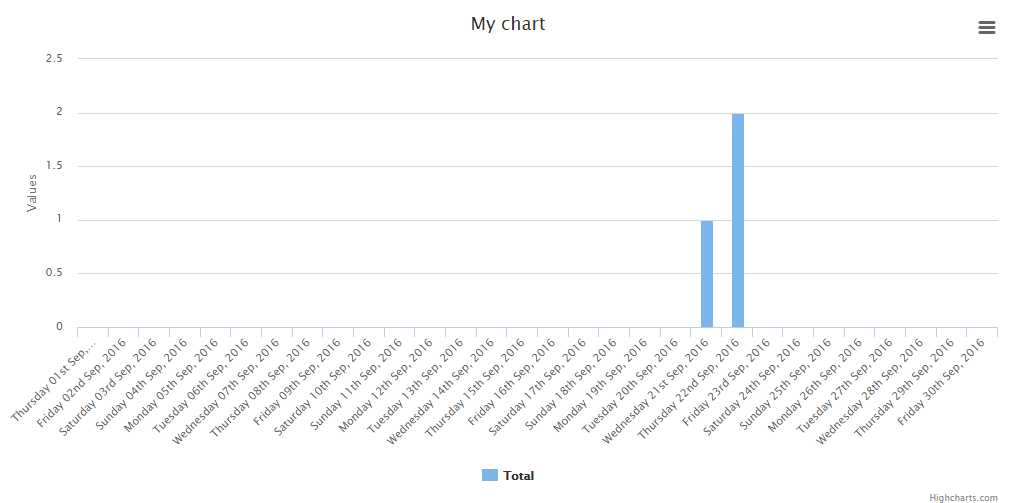 - groupByHour(optional string $day, optional string $month, optional string $year, optional boolean $fancy) Groups the data in hours (if no year/month/day set, the current one will be used). *Default:* $month = date('m'), $year = date('Y'), $fancy = false ```php $chart = Charts::database(User::all(), 'bar', 'highcharts') ->elementLabel("Total") ->dimensions(1000, 500) ->responsive(false) ->groupByHour() // to display a specific day and/or month and/or year, pass the parameters. For example to display the hours of May 12, 2017, and display a fancy output label: $chart = Charts::database(User::all(), 'bar', 'highcharts') ->elementLabel("Total") ->dimensions(1000, 500) ->responsive(false) ->groupByHour('12', '05', '2017', true) ```  - lastByYear(optional int $number) Alias for groupByYear() method. Does the same. *Default:* $number = 4 ```php $chart = Charts::database(User::all(), 'bar', 'highcharts') ->elementLabel("Total") ->dimensions(1000, 500) ->responsive(false) ->lastByYear(); // to display a number of years behind, pass a int parameter. For example to display the last 3 years: $chart = Charts::database(User::all(), 'bar', 'highcharts') ->elementLabel("Total") ->dimensions(1000, 500) ->responsive(false) ->lastByYear(3); ``` 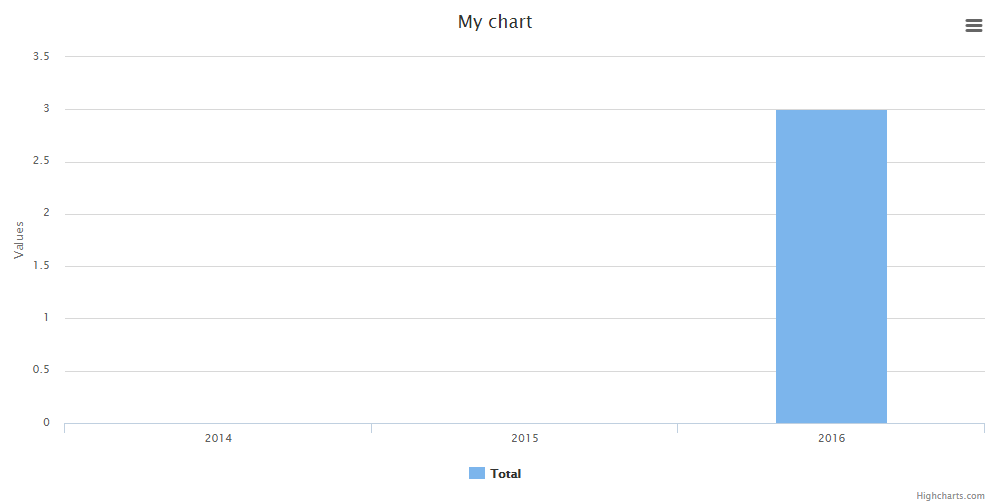 - lastByMonth(optional int $number, optional boolean $fancy) Display the numbers of months behind (relative to the current date). *Default:* $number = 6, $fancy = false ```php $chart = Charts::database(User::all(), 'bar', 'highcharts') ->elementLabel("Total") ->dimensions(1000, 500) ->responsive(false) ->lastByMonth(); // to display a number of months behind, pass a int parameter. For example to display the last 6 months and use a fancy output: $chart = Charts::database(User::all(), 'bar', 'highcharts') ->elementLabel("Total") ->dimensions(1000, 500) ->responsive(false) ->lastByMonth(6, true); ``` 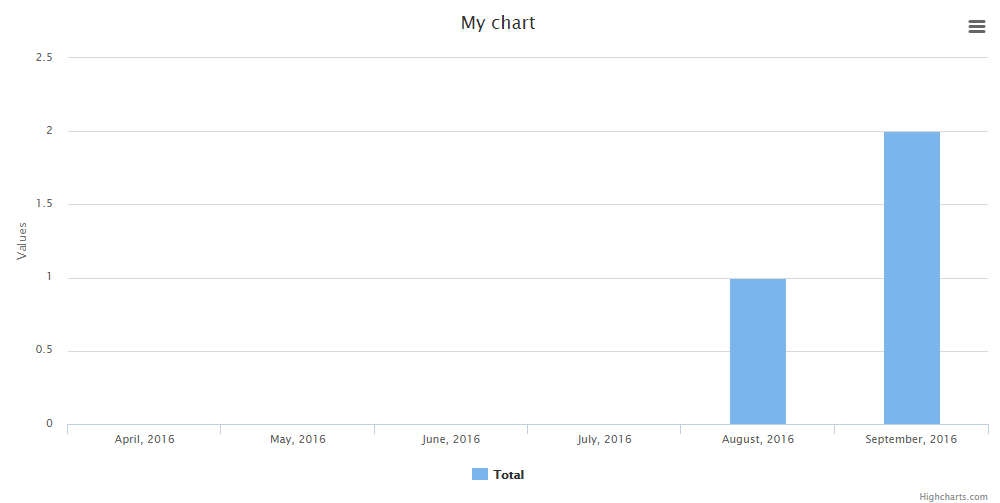 - lastByDay(optional int $number, optional boolean $fancy) Display the numbers of days behind (relative to the current date). *Default:* $number = 7, $fancy = false ```php $chart = Charts::database(User::all(), 'bar', 'highcharts') ->elementLabel("Total") ->dimensions(1000, 500) ->responsive(false) ->lastByDay(); // to display a number of days behind, pass a int parameter. For example to display the last 14 days and use a fancy output: $chart = Charts::database(User::all(), 'bar', 'highcharts') ->elementLabel("Total") ->dimensions(1000, 500) ->responsive(false) ->lastByDay(14, true); ``` 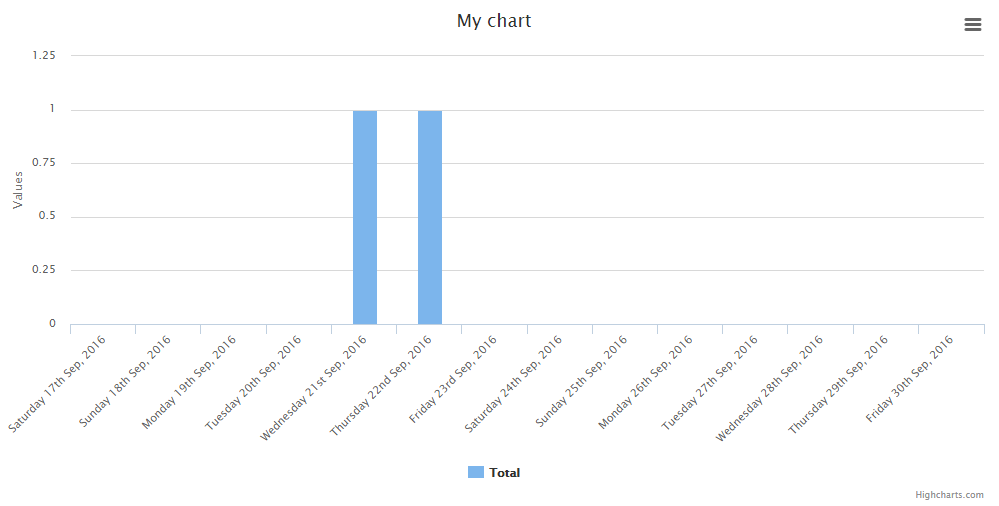 - preaggregated(boolean $preaggregated) Set to true if using an aggregate database query such as count, max, min, avg, and sum. ```php $data = Orders::select('orders.created_at', DB::raw('count(orders.id) as aggregate'))->groupBy(DB::raw('Date(orders.created_at)'))->get(); //must alias the aggregate column as aggregate $chart = Charts::database($data)->preaggregated(true)->lastByDay(7, false); ``` - aggregateColumn(string $aggregateColumn, string $aggregateType) This is similar to preaggregate. If you do not want to maintain extra data or simply want to leverage the search speed of the database use preaggregate. If you need to maintain the extra data from a record use this form (possibly for drilldown extension). Pass in a string representation of a column containing numeric values to be summed. Assume a collection of BankRecord with a numeric column called 'amount'. ```php $chart = new Database(BankRecord::all(), 'bar', 'highcharts'); $chart->aggregateColumn('amount', 'sum'); ``` This will yield summed values for column 'amount'. ### Database alternative method When creating charts, you might wanna take full control of it, this might be done creating the chart with the ```create``` method and adding the data from the database:
$data = Shopping::all(); $chart = Charts::create('bar', 'highcharts') ->title('My nice chart') ->elementLabel('My nice label') ->labels($data->pluck('shoppingDate')) ->values($data->pluck('price')) ->responsive(true);
## Multi Database Charts {#multi-database-charts}
Sometimes it might be usefull to create multi charts from diferent tables, right?
Fear no more, as this feature is there for you!
*Working Standard:* This chart is kinda special, the class extends the multi chart class and that means
that any option available in the multi chart is avalable here. BUT as this is a database chart, you
need to add the dataset in the following way:
```php
Charts::multiDatabase('line', 'material')
->dataset('Element 1', Users::all())
->dataset('Element 2', Posts::all());
And remember, you got all the database functions linked, meaning you're able to play with them as well like this:
Charts::multiDatabase('line', 'material') ->dataset('Element 1', Users::all()) ->dataset('Element 2', Posts::all()) ->groupByMonth(2017, true);
As mentioned above, this chart got all the available database methods and multi chart methods.
Realtime Charts {#realtime-charts}
| Realtime Charts | line | area | bar | pie | donut | geo | gauge | temp | percentage | progressbar | scatter |
|---|---|---|---|---|---|---|---|---|---|---|---|
| echarts | - | - | - | - | - | - | - | - | - | - | - |
| chartjs | - | - | - | - | - | - | - | - | - | - | - |
| highcharts | x | x | x | - | - | - | - | - | - | - | - |
| - | - | - | - | - | - | x | - | - | - | - | |
| material | - | - | - | - | - | - | - | - | - | - | - |
| chartist | - | - | - | - | - | - | - | - | - | - | - |
| fusioncharts | - | - | - | - | - | - | - | - | - | - | - |
| morris | - | - | - | - | - | - | - | - | - | - | - |
| plottablejs | - | - | - | - | - | - | - | - | - | - | - |
| minimalist | - | - | - | - | - | - | - | - | - | - | - |
| c3 | - | - | - | - | - | - | - | - | - | - | - |
| canvas-gauges | - | - | - | - | - | - | x | x | - | - | - |
| justgage | - | - | - | - | - | - | x | - | x | - | - |
| progressbarjs | - | - | - | - | - | - | - | - | x | x | - |
You can create realtime charts.
Example json:
{"value":31}
'value' can be changed to different index name with valueName($string)
$chart = Charts::realtime(url('/path/to/json'), 2000, 'gauge', 'google') ->values([65, 0, 100]) ->labels(['First', 'Second', 'Third']) ->responsive(false) ->height(300) ->width(0) ->title("Permissions Chart") ->valueName('value'); //This determines the json index for the value
Note: The interval is set in ms
The available methods are:
-
valueName(required string $string)
Sets the value json index.
Default: value
$chart = Charts::realtime(url('/path/to/json'), 2000, 'gauge', 'google') ->values([65, 0, 100]) ->labels(['First', 'Second', 'Third']) ->responsive(false) ->height(300) ->width(0) ->title("Permissions Chart") ->valueName('value'); //This determines the json index for the value
-
url(required string $url)
Sets the url after chart object creation.
$chart = Charts::realtime(url('/path/to/json'), 2000, 'gauge', 'google') ->values([65, 0, 100]) ->labels(['First', 'Second', 'Third']) ->responsive(false) ->height(300) ->width(0) ->title("Permissions Chart") ->url(url('/new/json'));
-
interval(required int $interval)
Sets the interval after chart object creation (ms).
$chart = Charts::realtime(url('/path/to/json'), 2000, 'gauge', 'google') ->values([65, 0, 100]) ->labels(['First', 'Second', 'Third']) ->responsive(false) ->height(300) ->width(0) ->title("Permissions Chart") ->interval(3000); // in ms
-
maxValues(required int $number)
Sets the max amount of values to be seen before removing the first one.
$chart = Charts::realtime(url('/path/to/json'), 1000, 'area', 'highcharts') ->responsive(false) ->height(300) ->width(0) ->title("Permissions Chart") ->maxValues(10);
Math Functions Charts {#math-functions-charts}
You can create math function charts.
Charts::math('sin(x)', [0, 10], 0.2, 'line', 'highcharts');
The function is sin(x), the interval is [0, 10] and the x amplitude is 0.2
-
function(required string $function)
Sets the function.
Charts::math('sin(x)', [0, 10], 0.2, 'line', 'highcharts')->mathFunction('x+1');
-
interval(required array $interval)
Sets the function / chart interval.
Charts::math('sin(x)', [0, 10], 0.2, 'line', 'highcharts')->interval([2, 8]);
-
amplitude(required int $amplitude)
Sets the function amplitude between x points.
Charts::math('sin(x)', [0, 10], 0.2, 'line', 'highcharts')->amplitude(0.5);
-
calculate()
Calculates the values / labels for the chart.
Note: This function is called every time a modification is made in the chart function, interval or amplitude so you don't need to call it every time you change the values. It's just an auxiliary function.
Charts::math('sin(x)', [0, 10], 0.2, 'line', 'highcharts')->calculate();
URL Charts (Ajax) {#url-charts}
BETA FEATURE WITH CHANGES FOR THE NEXT MAJOR RELEASE
Currently only highcharts is supported.
Since sometimes you need to create a lot of charts and they perhaps require a lot of operations, we allow loading the chart data from a URL with ajax.
Example Response from /api/data-url
{labels: ['test1', 'test2', 'test3', 'test4'], values: [1, 2, 3, 4]}
Charts::url(url('/api/data-url'), 'line', 'highcharts');
-
url(required string $url)
Sets the chart URL (ajax URL).
-
method(required string $method)
Sets the URL method. Defaults to 'GET'.
-
data(required array $data)
Set the data to be sent with the HTTP request. This might be usefull for sending auth tokens.
-
valuesName(required string $values_name)
Set the JSON value name key. Defaults to
valuesExample:
$values_name = 'values2';
{labels: ['test1', 'test2', 'test3', 'test4'], values2: [1, 2, 3, 4]} -
labelsName(required string $labels_name)
Set the JSON labels name key. Defaults to
labelsExample:
$labels_name = 'labels2';
{labels2: ['test1', 'test2', 'test3', 'test4'], values: [1, 2, 3, 4]} -
loadingText(required string $loading_text)
Set the loading text of the chart.
Multi URL charts (Ajax) {#multi-url-charts}
BETA FEATURE WITH CHANGES FOR THE NEXT MAJOR RELEASE
This class extends the base URL, so all functions there are available.
It works the same way, but expects a different response:
{
'dataset1': [1, 2, 3, 4],
'dataset2': [4, 3, 2, 1]
}
Charts Functions {#charts-functions}
-
create(optional string $type, optional string $library)
Returns a new chart instance, if no library is specified, the default one will be used.
Charts::create('line'); Charts::create('line', 'highcharts');
-
database(required mixed $object, optional string $type, optional string $library)
Returns a new database chart instance that extends the base one.
Charts::database(User::all()); Charts::create(User::all(), 'line', 'highcharts');
-
realtime(required string $url, required int $interval, optional string $type, optional string $library)
Returns a new database chart instance that extends the base one.
Charts::realtime(url('/json/data'), 2000, 'gauge', 'google')
-
math(required string $function, required array $interval, required int $amplitude, optional string $type, optional string $library)
Returns a new math function chart instance that extends the base one.
Charts::math('sin(x)', [0, 10], 0.2, 'line', 'highcharts');
-
multi(optional string $type, optional string $library)
Returns a new multi chart instance that extends the base one.
Charts::multi('line', 'material');
-
multiDatabase(optional string $type, optional string $library)
Returns a new multi database chart instance that extends the multi chart but can use the database functions.
Charts::multi('line', 'material');
-
assets(optional array $libraries)
Returns all the assets to generate the graphs.
To output only certain libraries, add an array to it with the libraries you want
<?php echo Charts::assets(); ?> // Using blade {!! Charts::assets() !!} // Only certain libraries {!! Charts::assets(['google', 'chartjs']) !!}
-
styles(optional array $libraries)
Returns all the style assets.
// All libraries {!! Charts::styles() !!} // Only certain libraries {!! Charts::styles(['google', 'material']) !!}
-
scripts(optional array $libraries)
Returns all the script assets.
// All libraries {!! Charts::styles() !!} // Only certain libraries {!! Charts::styles(['google', 'material']) !!}
-
libraries(optional string $type)
Returns an array of all the libraries available (can be filtered).
// Return all the libraries available print_r(Charts::libraries()); // Return all the libraries available for the line chart print_r(Charts::libraries('line'));
-
types(optional string $library)
Returns an array of all the chart types available (can be filtered).
// Return all the chart types available print_r(Charts::types()); // Return all the chart types available for the highcharts library print_r(Charts::types('highcharts'));
Available Chart Settings {#available-chart-settings}
-
loader(required bool $loader)
Set the chart loader animation enabled or disabled.
Charts::create('line', 'highcharts')->loader(false);
-
loaderDuration(required int $duration)
Set the duration of the chart loader animation in ms.
Charts::create('line', 'highcharts')->loader(true)->loaderDuration(2000);
-
loaderColor(required string $color)
Set the loader color.
Charts::create('line', 'highcharts')->loader(true)->loaderColor('#FF0000');
-
backgroundColor(required string $background_color)
Set the background color for the loader.
Charts::create('line', 'highcharts')->backgroundColor('#FF0000');
-
template(required string $template)
Set an available color template for the chart.
Note: They are defined in
config/charts.phpfile, under the templates key.Charts::create('line', 'highcharts')->template('material');
-
oneColor(required bool $one_color)
Specifies if the chart will only use the first color, regardless of the ammount of values.
Charts::create('line', 'highcharts')->oneColor(true);
-
credits(required bool $credits)
Set the credits enabled or disabled if the library supports it.
Charts::create('line', 'highcharts')->credits(false);
-
container(required string $division)
Set a custom division ID to render the chart at
Charts::create('line', 'google')->container('my-division-id');
-
view(required string $view)
Set a custom view to render the chart
Charts::create('line', 'google')->view('my.view');
-
region(required string $region)
Set the region for google geo chart
Default: world
Charts::create('geo', 'google')->region('FR');
-
gaugeStyle(required string $style)
Set the gauge style
Default: left
Available options:
leftrightcenterCharts::create('gauge', 'google')->gaugeStyle('right');
-
type(required string $type)
Set the chart type after creation (Example: from line to pie).
Charts::create('line', 'highcharts')->type('pie');
-
library(required string $library)
Set the chart library after creation (Example: from highcharts to google).
Charts::create('line', 'highcharts')->library('google');
-
labels(required array $labels)
The labels of the chart.
Charts::create('line', 'highcharts')->labels(['First', 'Second', 'Third']);
-
values(required array $values)
The values of the chart respectively.
Charts::create('line', 'highcharts')->values([10, 50, 100]);
-
elementLabel(required string $element_label)
The element label for line / bar / geo charts.
Charts::create('line', 'highcharts')->elementLabel('Total Views');
-
title(required string $title)
The chart title.
Charts::create('line', 'highcharts')->title('My Chart');
-
colors(required array $colors)
The colors of the charts respectively.
Charts::create('line', 'highcharts')->colors(['#ff0000', '#00ff00', '#0000ff']);
-
width(required int $width)
The chart width if non-responsive. 0 = responsive width.
Charts::create('line', 'highcharts')->width(1000);
-
height(required int $height)
The chart height if non-responsive. 0 = responsive height.
Charts::create('line', 'highcharts')->height(500);
-
dimensions(required int $width, required int $height)
The chart dimensions (shortcut to set width, height with one function).
Charts::create('line', 'highcharts')->height(1000, 500);
-
responsive(required boolean $responsive)
Set if the chart is responsive or not. If not, the chart dimensions will be used.
Charts::create('line', 'highcharts')->responsive(false);
-
legend(required boolean $legend)
Set whether to display the chart legend or not. Currently only works with
highcharts.Default: true
Charts::create('line', 'highcharts')->legend(false);
-
x_axis_title(required boolean $x_axis_title)
Set title of the x-axis. Currently only works with
highcharts.Default: false
Charts::create('line', 'highcharts')->x_axis_title('Year');
-
y_axis_title(required boolean $y_axis_title)
Set title of the y-axis. Currently only works with
highcharts.Default: null
Note: When set to
nullthe value for element_label will be used instead.Charts::create('line', 'highcharts')->y_axis_title('Number of Units');
-
language(required string $language)
Set the chart language. (Only for database and multiDatabase charts). Will be used before retrieve data with ->lastBy..() or ->GroupBy..() functions. It will translate date labels.
Charts::database(User::all(), 'line', 'highcharts')->language('es');
-
settings()
Return the chart settings.
print_r(Charts::create('line', 'highcharts')->settings());
-
render()
Render the chart.
echo Charts::create('line', 'highcharts')->labels(['One', 'Two'])->values([10, 20])->render();
Chart Examples {#chart-examples}
Pie
Charts::create('pie', 'highcharts') ->title('My nice chart') ->labels(['First', 'Second', 'Third']) ->values([5,10,20]) ->dimensions(1000,500) ->responsive(false);
Donut / Doughnut
Note: chartist can't change the color of this chart. Well it can but it's complicated, so I leave it here.
Charts::create('donut', 'highcharts') ->title('My nice chart') ->labels(['First', 'Second', 'Third']) ->values([5,10,20]) ->dimensions(1000,500) ->responsive(false);
Line
Charts::create('line', 'highcharts') ->title('My nice chart') ->elementLabel('My nice label') ->labels(['First', 'Second', 'Third']) ->values([5,10,20]) ->dimensions(1000,500) ->responsive(false);
Area
Charts::create('area', 'highcharts') ->title('My nice chart') ->elementLabel('My nice label') ->labels(['First', 'Second', 'Third']) ->values([5,10,20]) ->dimensions(1000,500) ->responsive(false);
Areaspline
Charts::multi('areaspline', 'highcharts') ->title('My nice chart') ->colors(['#ff0000', '#ffffff']) ->labels(['Monday', 'Tuesday', 'Wednesday', 'Thursday', 'Friday','Saturday', 'Sunday']) ->dataset('John', [3, 4, 3, 5, 4, 10, 12]) ->dataset('Jane', [1, 3, 4, 3, 3, 5, 4]);
Bar
Charts::create('bar', 'highcharts') ->title('My nice chart') ->elementLabel('My nice label') ->labels(['First', 'Second', 'Third']) ->values([5,10,20]) ->dimensions(1000,500) ->responsive(false);
Geo
Note: The labels must have the country codes, not the name.
Note 2: To add color to the chart, you'll need to provide an array of at least 2 colors. The first is the min and the second the max.
Charts::create('geo', 'highcharts') ->title('My nice chart') ->elementLabel('My nice label') ->labels(['ES', 'FR', 'RU']) ->colors(['#C5CAE9', '#283593']) ->values([5,10,20]) ->dimensions(1000,500) ->responsive(false);
Gauge
Note: You either need 1 value or 3 following this standard: [actualValue, minValue, maxValue]
Charts::create('gauge', 'canvas-gauges') ->title('My nice chart') ->elementLabel('My nice label') ->values([65,0,100]) ->responsive(false) ->height(300) ->width(0);
Temperature
Note: You either need 1 value or 3 following this standard: [actualValue, minValue, maxValue]
Charts::create('temp', 'canvas-gauges') ->title('My nice chart') ->elementLabel('My nice label') ->values([65,0,100]) ->responsive(false) ->height(300) ->width(0);
Percentage
Note: You either need 1 value or 3 following this standard: [actualValue, minValue, maxValue]
Charts::create('percentage', 'justgage') ->title('My nice chart') ->elementLabel('My nice label') ->values([65,0,100]) ->responsive(false) ->height(300) ->width(0);
Progressbar
Note: You either need 1 value or 3 following this standard: [actualValue, minValue, maxValue]
Charts::create('progressbar', 'progressbarjs') ->values([65,0,100]) ->responsive(false) ->height(50) ->width(0);
Credits Disable
Note: highcharts credits disable available. Default credits is enable.
Charts::multi('line', 'highcharts')->credits(false);
Charts in tabs {#cjarts-in-tabs}
Rendering charts on tabs will cause them to render very bad. The cause is that unactive tabs have no dimensions and charts try to adapt to a 0 dimensions division.
Lucky for you I'll add a quick method to make it work!
-
Create a layout, call it something like:
layoyts/charts.blade.php<!doctype html> <html lang="en"> <head> <meta charset="utf-8"> {!! Charts::assets() !!} <!--[if lt IE 9]> <script src="https://cdnjs.cloudflare.com/ajax/libs/html5shiv/3.7.3/html5shiv.js"></script> <![endif]--> </head> <body> @yield('chart') </body> </html> -
Create a new folder where you'll add all charts, for example:
charts/ -
Create a new file inside, for example:
latest_users.blade.phpand add the chart@extends('layouts.charts') @section('chart') {!! Charts::database(App\User::all(), 'line', 'material')->dimensions(0,$height)->title('Latest Users')->lastByDay(7, true)->elementLabel('New Users')->render() !!} @endsection -
Create a new route in
routes/web.phpRoute::get('/charts/{name}/{height}', 'ChartsController@show')->name('chart'); -
Create a new Controller
ChartsController<?php namespace App\Http\Controllers; use Illuminate\Http\Request; use Auth; class ChartsController extends Controller { /* Charts that will be protected to normal users */ public $protected_charts = ['admin_dashboard']; /** * Show the chart, made to be displayed in an iframe. * * @param int $name * @param int $height */ public function show($name, $height) { if (in_array($name, $this->protected_charts)) { $this->checkProtected(); } return view("charts.$name", ['height' => $height]); } /** * Protected charts will go here first. * You can change this condition how you like. */ public function checkProtected() { if(!Auth::user()->admin) { abort(404); } } }Make sure to change your stuff, it's all documented
-
Go to your view where you have your tabs, and inside that tab you like add the chart iframe with the height.
Note: This example uses materializecss. They have a loader that makes it cooler to load up charts :)
@php $chart_height = 300; @endphp <div class="card-panel" style="height: {{ $chart_height + 50 }}px"> <!-- Start materialize loader --> <center> <div class="preloader-wrapper big active" style="margin-top: {{ ($chart_height / 2) - 32 }}px;"> <div class="spinner-layer spinner-blue-only"> <div class="circle-clipper left"> <div class="circle"></div> </div> <div class="gap-patch"> <div class="circle"></div> </div> <div class="circle-clipper right"> <div class="circle"></div> </div> </div> </div> </center> <!-- End materialize loader --> <iframe id="latest_users" src="{{ route('chart', ['name' => 'latest_users', 'height' => $chart_height]) }}" height="{{ $chart_height + 50 }}" width="100%" style="width:100%; border:none;"></iframe> </div> -
Add this script changing the tab id with yours
Note: As you can see it also uses the loader from materializecss, you can remove them as well.
<script> $(function() { // Your tab id must match with the click element: administration_toggle // Change it how you like :) $('#administration_toggle').click(function() { $('.preloader-wrapper').fadeIn(); $('iframe').css('opacity', 0); setTimeout(function() { $('iframe').each(function() { $(this).attr('src', $(this).attr('src')); }); $('.preloader-wrapper').fadeOut(); setTimeout(function() { $('iframe').animate({ opacity: 1, }, 1000); }, 500); }, 500); }); }); </script>
Extend your way! {#extend-your-way}
You can create your own Charts by forking this repository. The src/Templates folder contains all the current charts, but you can
add yours like this:
Create a new file
Create a new file, the syntax is: library.type.php
if your chart library is called: mylib
and your template is for the line chart: line
Then you create a file like this: mylib.line.php
To call it later, just use:
$chart = Charts::create('line', 'mylib');
You will need to add the CSS / JS to the includes.php file found in the /src folder.
You have plenty of examples to see how to put the data so just take a closer look at all the included templates before doing yours!
